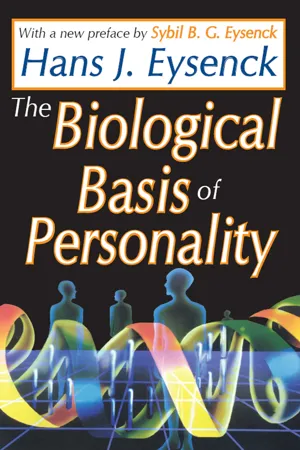![]()
REFERENCES
(Page reference numbers appear in boldface type.)
ACKNER, B., AND PAMPIGLIONE, G.: An evaluation of the sedation threshold test. J. Psychosom. Res., 3:271-281, 1959; 275, 280.
ADAMS, J. A.: Vigilance in the detection of low intensity visual stimuli. J. Exp. Psychol., 52:204-208, 1956; 334.
ADEY, W. R.; SEJUNDO, J. P., AND LIVINGSTON, R. B.: Corticifugal influences on intrinsic brain stem conduction in cat and monkey. J. Neurophysiol., 20:1-16, 1957; 239.
AIBA, S. The suppression of the primary visual stimulus. In: H. J. EYSENCK (Ed.), Experiments with Drugs. New York, Pergamon, 1963; 291, 294.
ALLEN, R. M.; RICHER, H. M. AND PLOTNIK, R. J.: A Study of introversion-extraversion as a personality dimension. Genet. Psychol. Monogr., 69:297-322, 1964; 178.
ALLPORT, F. H.: Social Psychology. New York, Houghton, 1924; 237.
ALTSCHULE, M. D.: Bodily Physiology in Mental and Emotional Disorders. New York, Grune, 1953; 59, 65, 66.
ANDERSON, A. L., AND HANVIK, L. J.: The psychometric localization of brain lesions: the differential effect of frontal and parietal lesions on M.M.P.I. profiles. J. Clin. Psychol., 6: 177-180, 1950; 333.
ANDREASSI, J. L.: Skin-conductance and reaction-time in a continuous auditory monitoring task. Amer. J. Psychol., 79:470-474, 1966; 177.
ANTHONY, S.: Anxiety as a function of psychomotor and social behaviour. Brit. J. Psychol., 51:141-152, 1960; 154.
ARDIS, J. A., AND FRASER, B.: Personality and perception: the constancy effect and introversion. Brit. J. Psychol., 48:48-54, 1957; 178.
ARMSTRONG, H. G.: The blood pressure and pulse rate as an index of emotional stability. Amer. J. Med. Sci., 195:211-220, 1938; 65.
ATKINSON, J. W.: An Introduction to Motivation. London, Van Nostrand, 1964; 166.
BAKAN, P.: Extraversion-introversion and improvement in an auditory vigilance task. Brit. J. Psychol., 50:325-332, 1959; 91, 334.
BAKAN, P.: Effect of meprobamate on auditory vigilance. Percept. Motor Skills, 12:26, 1961; 301.
BAKAN, P.: Time-of-day preference, vigilance, and extraversion-introversion. In: D. N. BUCKNER, and J. J. MCGRATH, (Eds.): Vigilance: A Symposium. New York, McGraw, 1963; 93.
BAKAN, P.; BELTON, J. A., AND TOTH, J. C.: Extraversion-introversion and decrement in an auditory vigilance task. In: D. N. BUCKNER and J. J. MCGRATH, (Eds.): Vigilance: A Symposium. New York, McGraw, 1963; 88.
BAKER, W. W.: Pharmacology of the central nervous system. Progress in Neurol. Psychiat., 16:95-123, 1961; 270.
BAKR, A. A.: Eperimenteller Nachweis der typologischen Bedeutung der Ranschburgschen homogenen Hemmung. Mainz, Unpublished Ph.D. thesis, 1963; 76.
BARTENWERFER, H.: Uber die Auswirkung einförmiger Arbeitsvorgänge; Untersuchungen zum Monotieproblem. Sitzungsber. Gesellsch. z. Beförd. d. ges. Naturwiss. zu Marburg, 80:1-70, 1957; 88.
BARTENWERFER, H.: Uber die Auswirkungen einföruniger Arbeitsvorgänge. Sitzungsberichte der Ges. z. Bef. d. ges. Naturwiss. zu Marburg., 80:1-70, 1957; 88.
BARTHOLOMEW, A. A.: Extraversion-introversion and neuroticism in first offenders and recidivists. Brit. J. Delinqu., 10:120-129,1959; 38.
BARTHOLOMEW, A. A., AND MARLEY, E.: Susceptibility to methylpentynol: personality and other variables. J. Ment. Sci., 105:955-970, 1959; 315.
BASOWITZ, H.; PERSKY, H.; KORCHIN, S. J., AND GRINKER, R. R.: Anxiety and Stress: An Interdisciplinary Study of a Life Situation. New York, McGraw, 1955; 59.
BATTERSBY, W. S.; BENDER, M., AND TEUBER, H. L.: Effects of total light flux on critical flicker frequency after frontal lobe lesion. J. Exp. Psychol., 42:135-142, 1951; 322.
BECKER, W. C.: Cortical inhibition and extraversion-introversion. J. Abnorm. Soc. Psychol., 61:52-66, 1960; 145, 179, 330.
BEECH, H. R., AND ADLER, F.: Some aspects of verbal conditioning in psychiatric patients. Behav. Res. Ther., 1:273-282, 1963; 123.
BEECHER, H. K.: Measurement of subjective responses. New York, Oxford, 1959; 109, 291.
BENDER, M., AND TEUBER, H. L.: Disturbances in visual perception following cerebral lesions. J. Psychol., 28:223-233, 1949; 322.
BENDIG, A. W.: College norms for, and concurrent validity of, the Pittsburgh revision of the Maudsley Personality Inventory. J. Psychol. Stud., 11:12-17, 1959; 38.
BENTON, A. L., AND BLACKBURN, H. L.: Practice effects in reaction-time tasks in brain-injured patients. J. abnorm. soc. Psychol., 54:109-113, 1957; 335.
BENTON, A. L., AND JOYNT, R. J.: Reaction-time in unilateral cerebral disease. Confin. Neurol., 19:247-256, 1959; 335.
BENTON, A. L.; SUTTON, S.; KENNEDY, J. A., AND BROKAW, J. R.: The cross- modal retardation in reaction time of patients with cerebral disease. J. Nerv. Ment. Dis., 135:413-418, 1962; 335.
BERGUM, B. O.: A taxonomic analysis of continuous performance. Percept. Motor Skills, 23:47-54, 1966; 99.
BERLYNE, D. E.: Conflict, Arousal and Curiosity. New York, McGraw, 1960; 110, 245.
BERNHAUT, M.; GELLHORN, E., AND RASMUSSEN, A. T.: Experimental contributions to the problem of consciousness. J. Neurophysiol., 16:21-36, 1953; 232.
BESSER, G. M.: Centrally acting drugs and auditory flutter. In: Proc. Sympos. on Drugs and Sensory Functions, Roy. Coll. Physicians, 1966; 923.
BESSER, G. M., DUNCAN, C., AND QUILLIAM, J. P.: Modification of the auditory flutter fusion threshold by centrally acting drugs in man. Nature, 211 (No. 5050):751, 1966; 293.
BIESHEUVEL, S.: The measurement of threshold for flicker and its value a...
